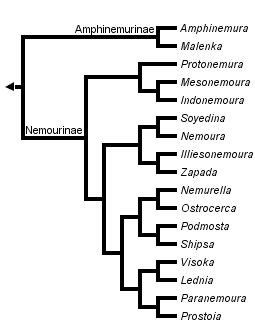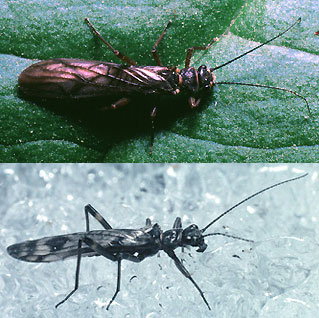Nemouridae
C. Riley Nelson


This tree diagram shows the relationships between several groups of organisms.
The root of the current tree connects the organisms featured in this tree to their containing group and the rest of the Tree of Life. The basal branching point in the tree represents the ancestor of the other groups in the tree. This ancestor diversified over time into several descendent subgroups, which are represented as internal nodes and terminal taxa to the right.

You can click on the root to travel down the Tree of Life all the way to the root of all Life, and you can click on the names of descendent subgroups to travel up the Tree of Life all the way to individual species.
For more information on ToL tree formatting, please see Interpreting the Tree or Classification. To learn more about phylogenetic trees, please visit our Phylogenetic Biology pages.
close boxIntroduction
Nemouridae is one of the largest families of Plecoptera with approximately 400 species divided between the nearctic, palearctic, and oriental regions (Baumann 1975). The nymphs are very distinctive in being broad, usually bristly, and having divergent wing pads. They occur in wide variety of streams but are probably most diverse in smaller creeks and spring runs.
Characteristics
Zwick (1973) listed four synapomorphies for the Nemouridae: 1, with testes large, long, and radiating from the anterior bend of the vas deferens in the shape of a star; 2, abdominal ganglia reduced to five; 3, last segment of the labial palpi large, round, and flattened; 3, the shape and site of insertion of the coxae. Baumann (1975) listed the synapomorphies for Amphinemurinae: 1, three lobed paraprocts; 2, paraprocts armed with spines or prongs. He listed the synapomorphy of the Nemourinae as having a ventral sclerite of the epiproct enlarged and with a very broad base.
References
Baumann, R. W. 1975. Revision of the stonefly family Nemouridae (Plecoptera) a study of the world fauna at the generic level. Smithsonian Contrib. Zool. 211: 1-74.
Nelson, C. H. 1984. Numerical cladistic analysis of phylogenetic relationships in Plecoptera. Ann. Entomol. Soc. Amer. 77: 466-473.
Zwick, P. 1973. Insecta: Plecoptera. Phylogenetisches System und Katalog. Das Tierreich 94. Walter de Gruyter and Co., Berlin. 465 pp.
About This Page
C. Riley Nelson

Brigham Young University, Provo, Utah, USA
Page copyright © 1996
All Rights Reserved.
Citing this page:
Nelson, C. Riley. 1996. Nemouridae. Version 01 January 1996 (under construction). http://tolweb.org/Nemouridae/13941/1996.01.01 in The Tree of Life Web Project, http://tolweb.org/








 Go to quick links
Go to quick search
Go to navigation for this section of the ToL site
Go to detailed links for the ToL site
Go to quick links
Go to quick search
Go to navigation for this section of the ToL site
Go to detailed links for the ToL site